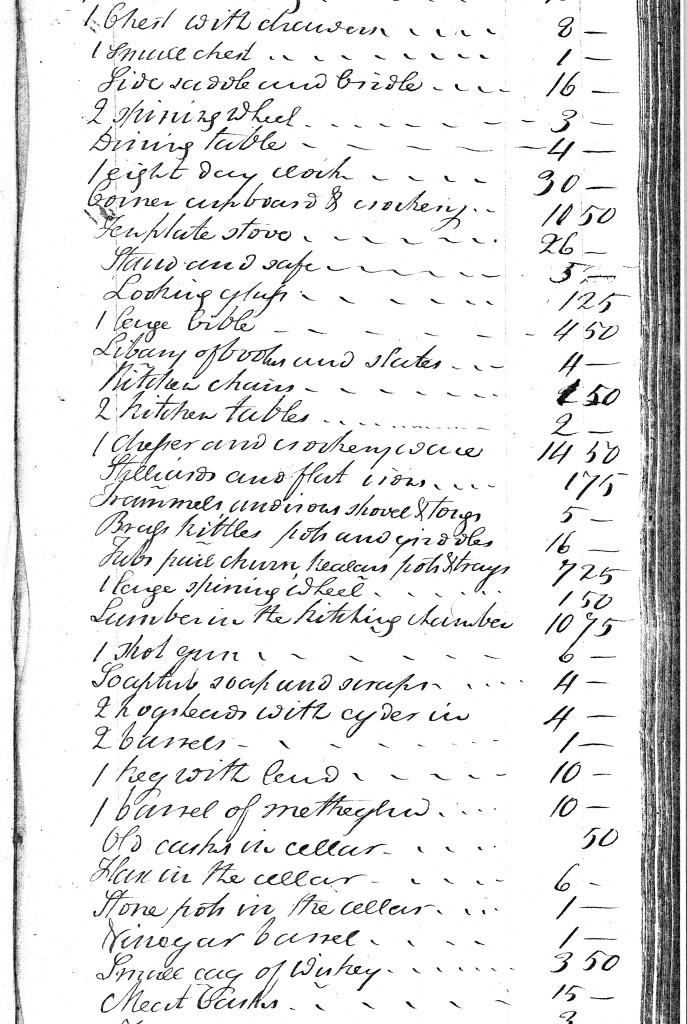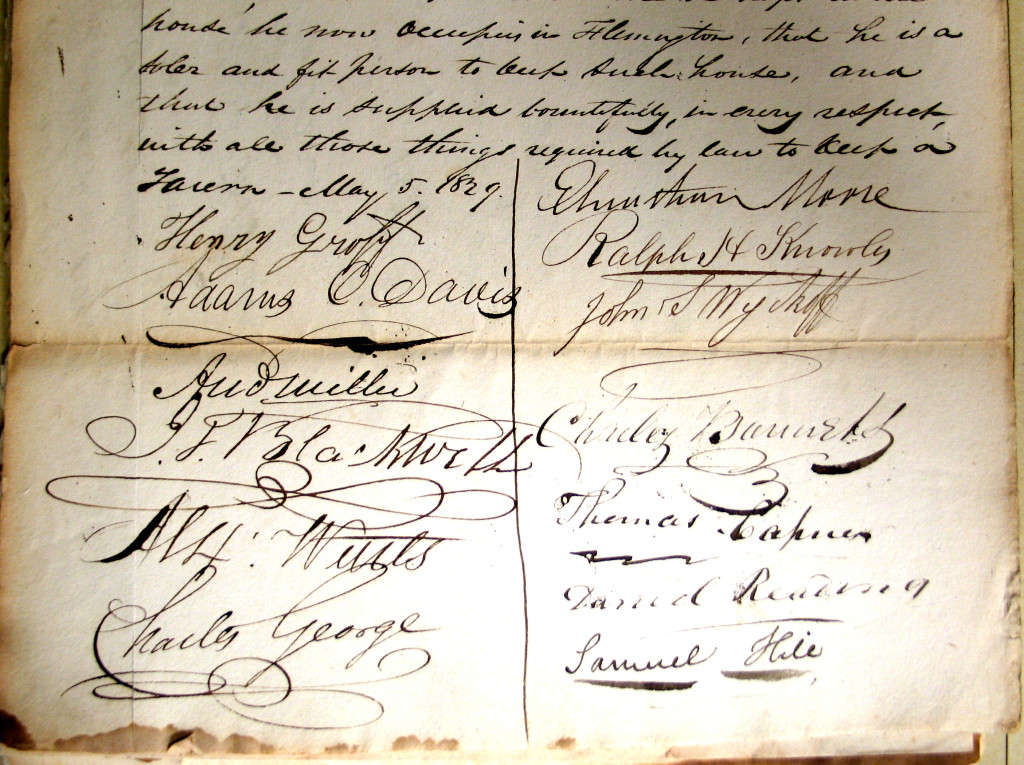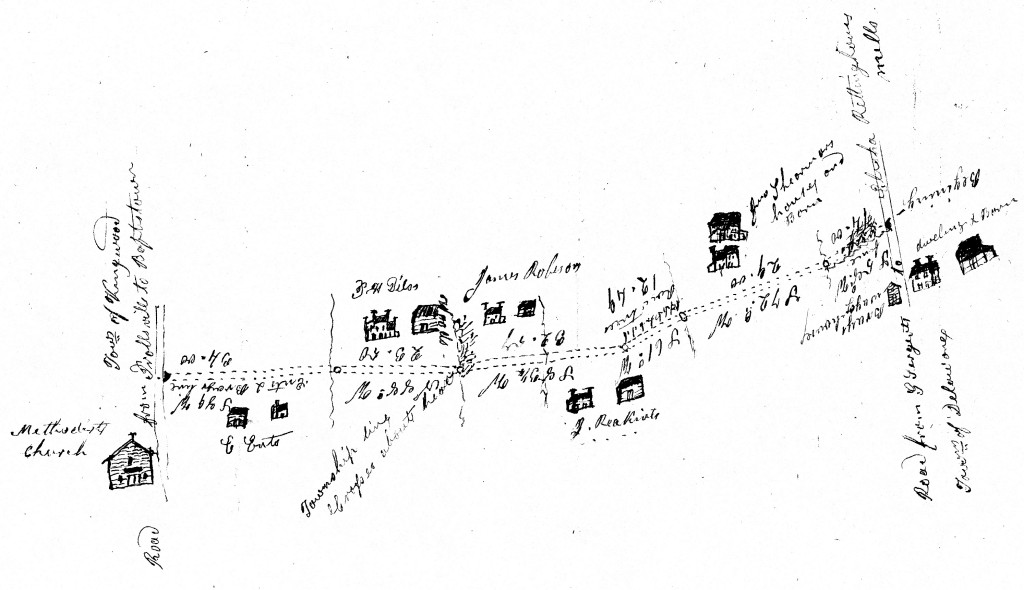This is the second part of my article on how to do a house history, published March 29th. If you followed through with that article, you will now have a more or less complete chain of title. So, what next?
Step Four. Flesh Out the Story
A chain of title for your property is wonderful to have, but, really, all it is is a list of names, dates and sources. There’s no story there. It’s not really very interesting until you start digging and learn about who these people were, what their lives were like. Were they rich, poor, farmers, merchants? Were they important in their community? Did they get into trouble? This is where genealogical skills come into play.
But first, a word about sources. You must learn to think like a judge in a court of law: everything must be proved as far beyond a reasonable doubt as possible. You can rely most on original documents, or official copies of deeds, mortgages, wills, court records. Also reliable are personal letters (originals), bible records, military records, account books, etc. Having said that, you may very well encounter contradictory records. People who kept records were not infallible. Even census records must be taken with a grain of salt. People were not always honest about their ages, or even their names.
In the previous post, I urged you to reach out to elderly residents with good memories. I should have added the caution that everyone’s memories alter as we age. As wonderful as these stories can be, you must take these with another grain of salt. The same goes for Genealogies, Local Histories, family traditions, newspaper stories. You may need a whole salt shaker before you’re done.
An excellent compilation of sources for research in Hunterdon County was prepared by Betty DeSapio. It is called “A Hunterdon Genealogy Guide,” and you can get a copy by contacting her at betty@desapioresearch.com.
Here are some good sources to check for more background on your property and the people who lived there:
- Surrogate’s Court for estate records
- Search Room for Special Deeds, Minutes of the Court of Common Pleas, Marriage Records, Road Records, Chattel Mortgages
- County Archives for military records, court records, tavern licenses, pedlers’ licenses and much more
- Hunterdon Co. Historical Society for all things genealogical like bible and burial records, and even some unrecorded deeds, as well as family genealogies, manuscript records and photographs; also tax ratables, census records, and estate records prior to 1804 on microfilm
- Hunterdon Co. Library for essential books on Hunterdon history and for maps. Both the Historical Society and the Library have the complete set of Documents Pertaining to the History of the State of New Jersey, which includes abstracts of wills and estates up to 1817, and newspaper extracts for the colonial and federal periods. Invaluable references.
- And of course, there are online sources, like “Find-a-Grave,” Ancestry.com, Family Search, Rootsweb, etc. Just a plain Google search can turn up interesting items, but be careful. Much of what is found online is unsourced. Treat the information as clues rather than as established facts.
- If you want to go further afield, there are lots of places that keep records that might pertain to your owners, starting with the State Archives in Trenton, the Alexander Library at Rutgers University, the N.J. Historical Society, Princeton Library, and The David Library in Bucks Co.
Where to Keep Your Records
In the previous post, I strongly recommended that you keep a log of your research, where you went and what you found, or didn’t find. It is also very helpful to have a place to keep all the documents you bring home. A binder and some file folders should do the trick. Here is one way to organize a research notebook in sections:
- General Property Information: Title Sheet, Copies of Historic Sites Survey, Tax Maps, Historic Maps, Transcripts of Oral Histories, Photographs
- Search Room Records: Abstracts of Deeds, Special Deeds, Mortgages, Marriage Records, Court Records, Divisions (keep copies in a separate, legal size folder)
- Surrogate’s Court Research: Abstracts or Copies of Wills, Inventories and other documents related to estates
- Genealogy from the Historical Society: Copies from the Deats Genealogical Files and Family Notebooks, Bible Records, records from microfilm
- Other Depositories: Information found online (make copies whenever possible—those websites might not last forever), State Archives, Rutger’s Alexander Library, the David Library, etc.
The Surrogate’s Court

Let’s get morbid. It’s a simple fact–what you really want is for at least one of your home’s owners to have died while living there. Why? Because then there will be an inventory of his or her possessions on file at the Surrogate’s Court, and there is nothing more fascinating than a list of items from the 18th or 19th century that were found in your home. Try to imagine being limited to the furniture and housewares that those earlier people owned. Imagine having to take care of all those animals, and do all that farming without modern equipment. Makes you realize how much things have changed.
While you’re at the Surrogate’s Court, check for the wills of owners who died elsewhere, after they left your home. Wills will tell you a lot about people and how they felt about their families. There are other estate records that can prove very important to your story, like the dockets, which contain original copies of the estate papers, including accounts made by the administrators.
There are index books to the estates on file at the Surrogate’s Court. They start with 1804. Earlier estates are stored at the State Archives in Trenton. But you don’t have to go to Trenton. If you have the NJA number (New Jersey Archives), which you can get from a published index available in the Surrogate’s office or at the Historical Society (all Hunterdon estates end with a J), you can go to the Historical Society and look for estates on microfilm. They are arranged by their NJA numbers.
One other precious resource at the Surrogate’s Court is Guardianships. If your home’s owner died while his or her children were still minors, the law required that those children had to have a guardian appointed for them. That guardian had to report to the Orphans Court on how he or she managed the children’s assets. Some wonderful things can be found in those records. Ask to see the index.1
Back to the dockets for estates after 1804. If you are focused on a particular person, ask Susan Hoffman, the Surrogate, or one of her assistants to have the docket files sent to her office from the County Archives, which is where they are stored. You will have to make a second trip to the Surrogate’s, but you may be rewarded by some valuable information.
The Surrogate’s Court has a record of Divisions made to properties to settle the rights of heirs. Similarly, the County Clerk’s Office has Partitions which were made when people who were sharing ownership of a property decided to separate their ownership into different lots. Both of these records sometimes have maps made by surveyors, and they can sometimes solve mysteries about what happened to your property.
County Archives
You can find original manuscript records here. They are definitely worth looking at if you want detailed information about a particular person. It is best to call ahead and speak to the archivist.2 Let him know who you are researching so he can check his database to see if he has records on that person. You can then set up a time to come in and see the records. It’s best to bring a smart phone or camera to make copies because these papers are fragile.

Among the wonderful records at the County Archives are petitions for tavern licenses. Your home owner may have run a tavern, or have signed someone else’s petition. If so, then you will be able to get a photocopy of that person’s original signature. (Signatures on deeds in the Search Room are not original; they were written out by the clerk.) An original signature is almost as good as a portrait, which you are not likely to find.
Newspapers
The major 19th century papers for Hunterdon are the Hunterdon Gazette (1825-1866), the Hunterdon County Republican (1856-1953) and the Hunterdon County Democrat (1838 to present). Thanks to the work of Bill Hartman, you can get abstracts of the Gazette on CD, which can be purchased from the Hunterdon County Historical Society. Abstracts of the Democrat, compiled by Dennis Sutton, are available online as a pdf. Abstracts of the Republican, another massive project by Bill Hartman, can also be found online in pdf format.
There are other newspapers of interest, like the Lambertville Beacon and the Democrat-Advertiser. You can find some of them on microfilm at the County Library and some of them in the original at the County Historical Society.
The newspapers will tell you a lot about what your home owners were up to. Not only can you find marriages and deaths (although not birth announcements, sorry), but associations like vigilante, bible or temperance societies, and political activities. It is surprising to find how many people held political office or at least positions in township government. The Hunterdon Gazette and Hunterdon Republican also published lists of people who were taxed during the Civil War.
In addition to telling you about your home’s owners, you can sometimes find information about your property—if it was sold by the Sheriff or by administrators of an estate. Sheriff’s sales happen when the owner cannot pay his bills and the court orders the Sheriff to seize the property and offer it at public sale to satisfy the creditors. The Sheriff is obliged by law to advertise the sale in newspapers and public places, and those ads can sometimes tell you amazing things about the house in question.
One example is a home that was advertised in 1840 being 35 by 18 feet, two stories with a cellar, “built of the best materials and well finished, divided into parlor, sitting room, and entry, on the first floor, and 3 rooms and entry on the second floor; kitchen adjoining, 23 feet long by 18 feet wide; a 14 feet lean-to attached.” I’ve never seen a more specific description in a newspaper ad. What a treasure.
Road Records

These are a little hard to use, but sometimes quite wonderful, if you’re lucky. Start with Phyllis D’Autrechy’s book, Abstract of Road Records. There is a copy at the Search Room—just ask for it. There is also an index map from which you can get the code for your location, which will help when you’re looking through the book. The D’Autrechy book will cite the book and page where the road survey was recorded (“returned”). It will also say whether there is a file on that road (files have 3 numbers separated by hyphens), and whether there is a map of the survey. Those maps are sometimes remarkable, showing not only the path of the road and its bordering owners, but even locations of houses. Make a copy and be sure to return the map to its file. These are precious records that must be preserved for future students of Hunterdon’s history.
There may be more to your house than a home.
Many houses in Hunterdon County originated not as family homes but as institutions like school or churches. Or they may have been homes that were used as taverns or inns. They have since been converted to residences, but their former use can make for a fascinating story. The old maps will often indicate what the earlier use was. But to get details about these churches, schools and taverns, consult that grand old book, James P. Snell’s History of Hunterdon and Somerset Counties, published in 1881, and available at the County Library and the Historical Society.
The above description covers most of the basic stuff. There’s much more to say about historic resources for Hunterdon researchers, but this should be enough to get you started. I’m still learning about what is available, and I’ve been at it for 30 years, so don’t get discouraged.
Step Five. What to Make of it All
So now you’ve got a stack of papers, which I hope you’ve organized in some fashion so that you can find things when you need to. You could just store it away and forget about it. But for a great house history, the job is not finished. One thing I have discovered by doing house histories and writing a blog is that you do not know what you’ve missed until you start writing the history down, in narrative form. There’s something about trying to tell a story that raises all sorts of unforeseen questions. It is a very good mental exercise, and I’m sure it will surprise you if you attempt it.
Here is a suggested outline for a finished house history.
Body:
- Title Page (as fancy as you’d like to make it)
- Chronology (chart or list, whichever you prefer)
- Chronological Narrative, enhanced with maps, old photographs, signatures from old documents, advertisements from old newspapers, etc.)
Appendix:
- Copies of all the deeds in the Chain of Title
- Wills and Inventories
- Architectural Review, if you’ve gotten one
- A Bibliography
- And if you’re really ambitious, an Index of Names
If you do this is, you will end up with something that is presentable and worth saving. The future owners of your house will appreciate it, as will all the relatives of your home’s owners who are struggling with their family research. The generous thing to do would be to write your house history, with sources in footnotes and an index of names, and donate it to the County Historical Society.
Not only will you develop a deep understanding of the history of your property and the people who lived there, but you will benefit all those others whose families once dwelled in your home.
Footnotes:
- Recently, legislation was passed restricting access to modern Guardianship papers. This means that if you need to look at a Guardianship file, no matter how old it is, you must get permission from an assignment judge. Ask the Deputy Surrogate for assistance. ↩
- When this article was published originally, the archivist was Larry Green. The current archivist is Al Illiano. Larry spent ten years putting all of the card catalogs (there were two of them) into a single database of over 30,000 people. With many people having several records apiece, the total number of records comes to well over 100,000. ↩
